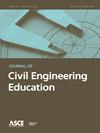{"title":"Impact of Modality on Workload among Engineering Undergraduates during the COVID-19 Pandemic","authors":"M. Watson, E. Barrella, K. Skenes","doi":"10.1061/jceecd.eieng-1879","DOIUrl":null,"url":null,"abstract":"The COVID-19 pandemic created unprecedented disruptions in models for engineering student training. At The Citadel, an undergraduate-focused college in the Southeastern United States, a variety of modalities were implemented following the onset of the pandemic, including emergency online and Hyflex learning. We conducted a longitudinal study to analyze the cognitive load among our undergraduate engineering students throughout changing modalities. Using data from the NASA Task Load Index (TLX) and open-ended reflections on student challenges, we found that total workload (a surrogate for cognitive load) was generally highest during emergency online learning in the second half of Spring 2020 semester, with experiences possibly varying across different demographic and academic groups. Emergency online challenges were often related to time management, personal organization, and responsibility for learning. In contrast, HyFlex challenges were often related to technology and communication challenges. While emergency online learning was a cognitive load disruption, that disruption was often associated with personal and/or academic development. HyFlex learning mediated cognitive load disruption;although, student challenges may have been simple nuisances rather than mediators of developmental change. © 2023 American Society of Civil Engineers.","PeriodicalId":48476,"journal":{"name":"Journal of Civil Engineering Education","volume":"1 1","pages":""},"PeriodicalIF":1.2000,"publicationDate":"2023-01-01","publicationTypes":"Journal Article","fieldsOfStudy":null,"isOpenAccess":false,"openAccessPdf":"","citationCount":"0","resultStr":null,"platform":"Semanticscholar","paperid":null,"PeriodicalName":"Journal of Civil Engineering Education","FirstCategoryId":"5","ListUrlMain":"https://doi.org/10.1061/jceecd.eieng-1879","RegionNum":4,"RegionCategory":"工程技术","ArticlePicture":[],"TitleCN":null,"AbstractTextCN":null,"PMCID":null,"EPubDate":"","PubModel":"","JCR":"Q3","JCRName":"EDUCATION, SCIENTIFIC DISCIPLINES","Score":null,"Total":0}
引用次数: 0
新冠肺炎疫情期间方式对工科大学生工作量的影响
2019冠状病毒病大流行对工程专业学生的培训模式造成了前所未有的破坏。在美国东南部的一所以本科生为重点的学院The Citadel,在疫情爆发后实施了多种模式,包括紧急在线学习和Hyflex学习。我们进行了一项纵向研究来分析我们的本科工程专业学生在不同模式下的认知负荷。利用NASA任务负荷指数(TLX)的数据和对学生挑战的开放式反思,我们发现,在2020年春季学期下半学期的紧急在线学习期间,总工作量(认知负荷的替代指标)通常是最高的,不同人口和学术群体的经历可能有所不同。紧急在线挑战通常与时间管理、个人组织和学习责任有关。相比之下,HyFlex的挑战通常与技术和通信挑战有关。虽然紧急在线学习是一种认知负荷中断,但这种中断通常与个人和/或学术发展有关。HyFlex学习介导认知负荷中断;虽然,学生的挑战可能是简单的滋扰,而不是发展变化的中介。©2023美国土木工程师学会。
本文章由计算机程序翻译,如有差异,请以英文原文为准。


